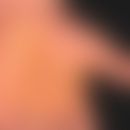Synonym(s)
HistoryThis section has been translated automatically.
DefinitionThis section has been translated automatically.
Autosomal recessive inherited keratinization disorder with diffuse transgressive palmoplantar keratoses, peridontitis, dental abnormalities, and susceptibility to infection.
You might also be interested in
EtiopathogenesisThis section has been translated automatically.
Mutations of the Papillon-Lefèvre syndrome gene(CTSC = Cathepsin C or PLS gene/gene locus: 11q14.1-q14.3). The mutations result in deficiency of a lysosomal protease (cathepsin C, see cathepsins below). Cathepsin C plays an important role in the activation of certain proteases involved in the phagocytosis of bacteria.
A variant of Papillon-Lefèvre syndrome, Haim-Munk syndrome is also caused by mutations in the CTSC gene.
ManifestationThis section has been translated automatically.
ClinicThis section has been translated automatically.
Integument: Transgressive diffuse palmoplantar keratosis, sharply demarcated redness of palmae and plantae spreading to dorsum of hands and feet, psoriasiform hyperkeratosis of elbows and knees, hyperhidrosis.
Extracutaneous manifestations: early caries, gingivitis, periodontopathy, alveolar atrophy, tooth loss in deciduous and permanent dentition (Giannetti L et al 2020).
Debility is possible
A slightly different phenotype is described as Haim-Munk variant with the same CTSC mutation. In addition to the PL symptoms, arachnodactyly, acroosteolysis, pes planus and deformities of the fingers are found.
Differential diagnosisThis section has been translated automatically.
TherapyThis section has been translated automatically.
LiteratureThis section has been translated automatically.
- Al-Khenaizan S (2002) Papillon-Lefevre syndrome: the response to acitretin. Int J Dermatol 41: 938-941
- Bergmann R et al (1988) Papillon-Lefèvre syndrome: a study of the long-term clinical course of recurrent pyogenic infections and the effects of etretinate treatment. Br J Dermatol 119: 731-736.
- Bork K et al (1980) Extrapalmoplantar skin symptoms and other clinical and etiologic, especially immunologic, aspects of Papillon-Lefèvre syndrome. Dermatologist 31: 179-183
- Giannetti L et al (2020) Papillon-Lefèvre syndrome: oral aspects and treatment. Dermatol Ther 33:e13336.
- Mortimer NJ et al (2004) Papillon-Lefevre syndrome: successful treatment of peridontitis, and preservation of dentition with acitretin. Br J Dermatol 151(Suppl 68): 44
- Pilger U et al (2003) Late-onset Papillon-Lefevre syndrome without alteration of the cathepsin C gene. J Am Acad Dermatol 49: S240-243.
- Papillon M, Lefèvre P (1924) Dens cas de keratodermie palmaire et plantaire symetrique familale (maladie de meleda) chez le frere et al soeur: co exdistence dans les deux cas d'alterations dentaires groups. Bull Soc Fr Dermatol Syph 31: 82-87.
- Ullbro C et al (2003) Dermatologic and oral findings in a cohort of 47 patients with Papillon-Lefevre syndrome. J Am Acad Dermatol 48: 345-351.
Incoming links (16)
Cathepsin; CTSC Gene ; Dental diseases, skin changes; Gingival hyperplasia; Haim munk syndrome; Hyperkeratosis palmoplantaris with periodontosis; Keratodermia palmoplantaris diffusa papillon; Keratosis palmoplantaris diffusa non circumscripta; Keratosis palmoplantaris with periodontosis; Keratosis palmoplantaris with periodontosis; ... Show allOutgoing links (13)
Acitretin; CTSC Gene ; Gingivitis; Hyperhidrosis (overview); Hyperkeratoses; Inverted psoriasis; Keratosis palmaris et plantaris cum surditate congenita et leuconychia totalis unguium; Keratosis palmoplantaris diffusa with mutation in keratin 1; Keratosis palmoplantaris diffusa with mutations in KRT 9; Palmoplantar keratoses (overview); ... Show allDisclaimer
Please ask your physician for a reliable diagnosis. This website is only meant as a reference.




